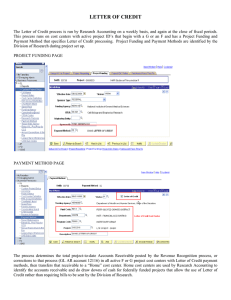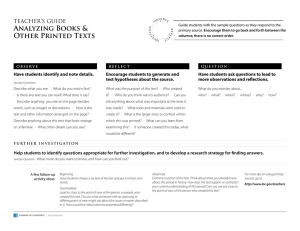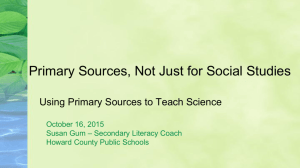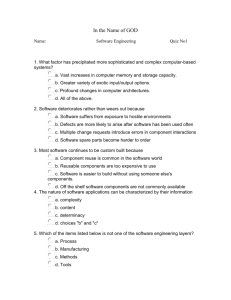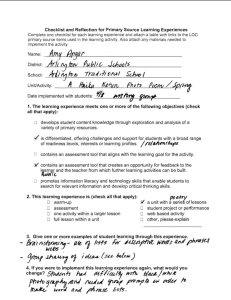Annotated Resource Set (ARS)
advertisement
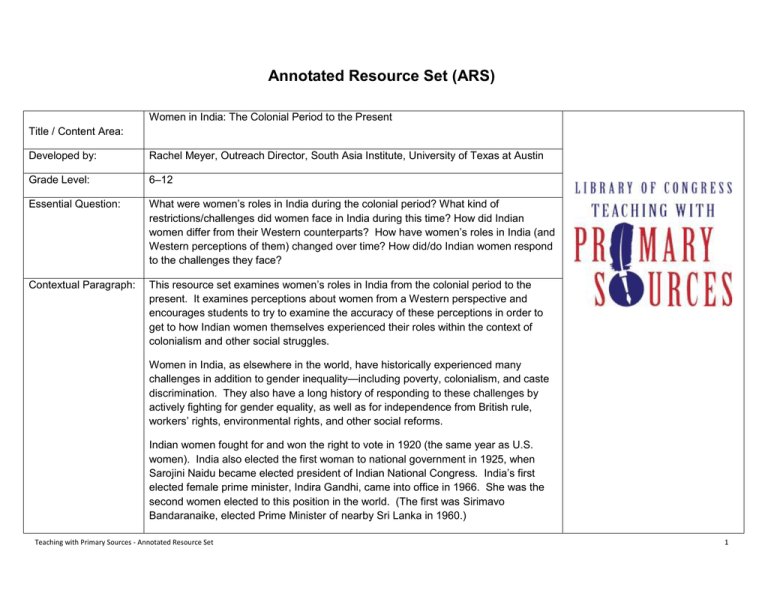
Annotated Resource Set (ARS) Women in India: The Colonial Period to the Present Title / Content Area: Developed by: Rachel Meyer, Outreach Director, South Asia Institute, University of Texas at Austin Grade Level: 6–12 Essential Question: What were women’s roles in India during the colonial period? What kind of restrictions/challenges did women face in India during this time? How did Indian women differ from their Western counterparts? How have women’s roles in India (and Western perceptions of them) changed over time? How did/do Indian women respond to the challenges they face? Contextual Paragraph: This resource set examines women’s roles in India from the colonial period to the present. It examines perceptions about women from a Western perspective and encourages students to try to examine the accuracy of these perceptions in order to get to how Indian women themselves experienced their roles within the context of colonialism and other social struggles. Women in India, as elsewhere in the world, have historically experienced many challenges in addition to gender inequality—including poverty, colonialism, and caste discrimination. They also have a long history of responding to these challenges by actively fighting for gender equality, as well as for independence from British rule, workers’ rights, environmental rights, and other social reforms. Indian women fought for and won the right to vote in 1920 (the same year as U.S. women). India also elected the first woman to national government in 1925, when Sarojini Naidu became elected president of Indian National Congress. India’s first elected female prime minister, Indira Gandhi, came into office in 1966. She was the second women elected to this position in the world. (The first was Sirimavo Bandaranaike, elected Prime Minister of nearby Sri Lanka in 1960.) Teaching with Primary Sources - Annotated Resource Set 1 Resource Set Ladies riding on elephant Primitive native life of India—Hindu women grinding at the mills Washington, D.C., International student assembly, Indian delegates, Benares—woman walking; stone steps in background Left to right: Miss Sita Guha Thakurta; K.Z. Fournadjiadieff, a student at Yale University; Miss Satiavati E. Cotelingan, a student at the Biblical Seminary; Miss Kamala Kosambi, a student at the University of Michigan http://www.loc.g ov/pictures/item/ 2004707752/ http://www.loc.gov/pict ures/item/92508657/ Teaching with Primary Sources - Annotated Resource Set http://www.loc.gov/pictures/i tem/owi2001009792/PP/ India in the war. Girl workers in a booming Bombay textile mill Miss Neil [and] a famine victim, India Thirty-five percent of India's great cotton textiles production, amounting to some 5,000,000,000 yards a year, is going into war materials for India and United Nations http://www.loc.gov/pictur es/item/2004707771/ http://www.loc.gov/pi ctures/item/oem2002 007110/PP/ http://www.loc.gov/ pictures/item/20076 82803/ 2 A Hindu bridal party The Ogden standardexaminer, February 06, 1921, MAGAZINE SECTION, Image 21A Drawing room of H.E. Lady Curzon and Hindu, Viceregal Palace, Simla, N. India Prime Minister Indira Gandhi of India at the National Press Club, Washington, D.C. “Brahmin Woman Leads Forces against Britain” http://www.loc. gov/pictures/ite m/99401520/ http://chroniclingamerica.l oc.gov/lccn/sn85058393/1 921-02-06/ed-1/seq21/;words=SAROJINI?date1 =1860&rows=20&searchTy pe=basic&state=&date2=1 922&proxtext=sarojini&y=1 4&x=8&dateFilterType=yea rRange&index=3 http://www.loc.gov/ pictures/item/92508 652/ http://www.loc.go v/pictures/item/20 04666286/ Annie Besant, half-length portrait, seated, facing slightly right Women of India carry on Gandhi salt campaign: wives of leaders active as violence grows Anne Besant went to India in 1893, an advocate for social reforms and a critic of British colonialism. “…the Rights of Man have become an accepted doctrine, but unfortunately that are only the rights of man, in the exclusive sense of the word…until they become human rights, society will never rest on a sure, just foundation” (Note: not yet digitized) http://www.loc.gov/pictures/item/917 86293/ http://www.loc.gov/ pictures/item/96504 839/ Notes/Comments: Teaching with Primary Sources - Annotated Resource Set 3 India: Women May be Employed as Bartenders Young Indian women, dressed in colorful saris, get military training ... on campus of Darrang College Patronage and Power: Women Movers and Shakers in the Indian Subcontinent - Panel III: Women Leaders in India's Independence Struggles Delivery of concert piano, Nagpur, India, 1923—Helena Morstyn, piano Link to newspaper article in The Hindu (Note: not yet digitized) Symposium on Library of Congress Website (Note: not yet digitized) (recordings and transcripts) Nayantara Sahgal (1927– ) Readings from Mistaken identity (1988). Associated Press photograph of Maharajah and Maharanee (Nancy Ann Miller) of Indore walking together Novels bring out Nayantara Sahgal as a writer with feminist concerns seeking independent existence of women. She sees women as victims of conventional Indian society engaged in their quest for identity. In her last novel Mistaken Identity her concept of emancipation reaches its pinnacle where her female character is an out-and-out rebel. (http://www.loc.gov/acq/ovop/delhi/salrp/ nayantarasahgal.html) http://www.hi ndu.com/2007 /12/07/stories /20071207559 30100.htm http://www.loc. gov/pictures/ite m/2005693445/ http://www.loc.gov/t oday/cyberlc/feature_ wdesc.php?rec=4049 Teaching with Primary Sources - Annotated Resource Set http://www.loc.gov/ pictures/item/97505 552/ http://lcweb2.loc.gov/mbrs/master/salrp/0 8002.mp3 http://hdl.loc.gov/loc.ndlpc oop/ichicdn.n090163 4 Jacqueline Kennedy Woman carrying large corrugated sheets Young woman street vendor holding measuring scales New York Tribune, October 09, 1921, Page 3, Image 27 “Tragedy of Being a Wife” The San Francisco call., August 31, 1913, Image 8 Having a bindi placed on her forehead, which is a sign of marriage, at Jaipur, India Arundhati Roy (1959– ) Readings from The god of small things (1997) The book, set among the Christian community of the southern state of Kerala, is a personal account of a tragic love story cutting across the caste, religious and political divides of India Roy has used her celebrity status in India to write in defense of causes she believes in. Almost unique among intellectuals, Roy publicly excoriated the Indian Government for its decision to launch nuclear tests in 1998. In 1999, Roy pointed her sharp pen against the Narmada dam, under construction in the states of Madhya Pradesh and Gujarat in another critical essay. (Note: not yet digitized) (http://www.loc.gov/acq/ovop/delhi/salrp/aru ndhathiroy.html) http://www.lo c.gov/pictures /item/925202 00/ http://www.loc. gov/pictures/ite m/2004707703/ http://www.loc.g ov/pictures/item /2004707709/ Teaching with Primary Sources - Annotated Resource Set http://chroniclingamerica .loc.gov/lccn/sn83030214 /1921-10-09/ed-1/seq27/;words=Sarojini?date1 =1860&rows=20&searchT ype=basic&state=&date2 =1922&proxtext=sarojini &y=14&x=8&dateFilterTy pe=yearRange&index=4 http://chroniclingamerica.loc. gov/lccn/sn85066387/191308-31/ed-1/seq8/;words=INDIA+women+Indi a+Women?date1=1860&rows =20&searchType=basic&state =&date2=1922&proxtext=indi a+women&y=0&x=0&dateFilt erType=yearRange&index=15 http://lcweb2.loc.gov/mbrs/master/salrp/035 01.mp3 5 Foundations Annotations Curriculum Connections Social Studies; Language Arts—Reading, Writing; Critical thinking; Information Literacy Curriculum Standards Texas Essential Knowledge and Skills (TEKS) 113.22 (Social Studies Grade 6) (1) History. The student understands that historical events influence contemporary events. The student is expected to: (B) analyze the historical background of selected contemporary societies to evaluate relationships between past conflicts and current conditions. (2) History. The student understands the contributions of individuals and groups from various cultures to selected historical and contemporary societies. The student is expected to: (A) explain the significance of individuals or groups from selected societies, past and present. (13) Citizenship. The student understands that the nature of citizenship varies among societies. The student is expected to: (A) describe roles and responsibilities of citizens in selected contemporary societies including the United States; (B) explain how opportunities for citizens to participate in and influence the political process vary among selected contemporary societies; and (C) compare the role of citizens in the United States with the role of citizens from selected democratic and nondemocratic contemporary societies. (15) Culture. The student understands the similarities and differences within and among cultures in different societies. The student is expected to: (C) analyze the similarities and differences among selected world societies. (18) Culture. The student understands the relationship that exists between artistic, creative, and literary expressions and the societies that produce them. The student is expected to: (A) explain the relationships that exist between societies and their architecture, art, music, and literature; (C) describe ways in which societal issues influence creative expressions. 113.33 (World History Studies) (1) History. The student understands traditional historical points of reference in world history. The student is expected to: (A) identify the major eras in world history and describe their defining characteristics; (C) apply absolute and relative chronology through the sequencing of significant individuals, events, and time periods. (17) Citizenship. The student understands the significance of political choices and decisions made by individuals, groups, and nations throughout history. The student is expected to: (A) evaluate political choices and decisions that individuals, groups, and nations have made in the past, taking into account historical context, and apply this knowledge to the analysis of choices and decisions faced by contemporary societies; and (B) describe the different roles of citizens and noncitizens in historical cultures, especially as the roles pertain to civic participation. (18) Citizenship. The student understands the historical development of significant legal and political concepts, including ideas about rights, republicanism, constitutionalism, and democracy. The student is expected to: (C) identify examples of political, economic, and social oppression and violations of human rights Teaching with Primary Sources - Annotated Resource Set 6 throughout history, including slavery, the Holocaust, other examples of genocide, and politically-motivated mass murders in Cambodia, China, and the Soviet Union; (D) assess the degree to which human rights and democratic ideals and practices have been advanced throughout the world during the 20th century. (20) Culture. The student understands the relationship between the arts and the times during which they were created. The student is expected to: (B) analyze examples of how art, architecture, literature, music, and drama reflect the history of cultures in which they are produced. (21) Culture. The student understands the roles of women, children, and families in different historical cultures. The student is expected to: (A) analyze the specific roles of women, children, and families in different historical cultures; and (B) describe the political, economic, and cultural influence of women in different historical cultures. Content & Thinking Objectives Research Skills for History: Historical research is a process in which students examine topics or questions related to historical studies and/or current issues. Students will learn to understand the difference between primary and secondary sources; choose question and analyze sources for a specific historical inquiry. Students will evaluate primary sources for authors main points; purposes and perspective; facts vs. opinions; different points of view on the same historical topic/event; credibility and validity. By using primary and secondary sources effectively, students learn to obtain accurate and relevant information, and develop strong questions for further inquiry. Emergence of Women’s Rights in India: Students will assess how social developments influenced women’s rights in colonial India, and understand women’s roles in India’s struggle for independence and women’s place within the new nation. Using India as case study, students will gain knowledge of systems of social structure and gender structure (comparing major features within India and in relation to the U.S., and assessing change and continuity). They will gain an understanding of the relationship between gender and empire (including the role of women in households and in politics); and make comparisons in the roles and conditions of women in the upper/middle classes with the working class. They will also gain an understanding of the processes of social reform and social revolution (changing gender roles; the rise of feminism). Other Resources Web Resources Lesson Plan on Hemispheres’s Website: Women in the India Independence Movement: The Salt Protests of 1930: http://www.utexas.edu/cola/orgs/hemispheres/_files/pdf/women/SaltMarch.pdf Other Symposium on Library of Congress Website (recordings and transcripts): Teaching with Primary Sources - Annotated Resource Set 7 Patronage and Power: Women Movers and Shakers in the Indian Subcontinent - Panel I: Women and Religion http://www.loc.gov/today/cyberlc/feature_wdesc.php?rec=4053 Patronage and Power: Women Movers and Shakers in the Indian Subcontinent - Panel II: Begums and Maharanis http://www.loc.gov/today/cyberlc/feature_wdesc.php?rec=4052 Patronage and Power: Women Movers and Shakers in the Indian Subcontinent - Panel IV: Women and Art http://www.loc.gov/today/cyberlc/feature_wdesc.php?rec=4051 Secondary Sources Books Domosh, Mona and Joni Seager. 2001. Putting Women in place: Feminist Geographers Make Sense of the World. Forbes, Geraldine. 1996. Women in Modern India. Kumar, Radha. 1993. The History of Doing: An Illustrated Account of Movements for Women’s Rights and Feminism in India, 1800–1990. Ramusack, Barbara and Sharon Sievers. 1999. Women in Asia: Restoring Women to History. Seagar, Joni. 2003. The Penguin Atlas of Women in the World. Teaching with Primary Sources - Annotated Resource Set 8

